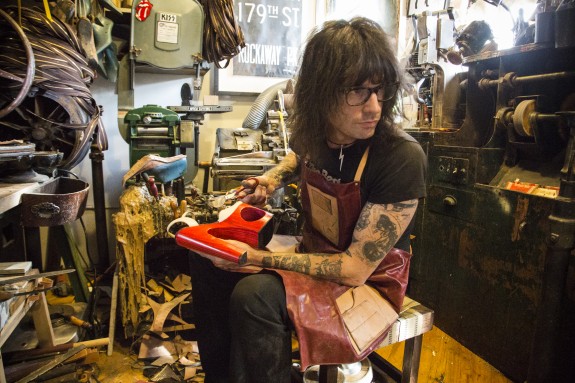
This post is one in a series that gives readers a sneak-peek into my new book Artifacts from American Fashion (Available November 30), as well as the research behind it. The book offers readers a unique look at daily life in twentieth-century America through the lens of fashion and clothing. It covers forty-five essential articles of fashion or accessories, chosen to illuminate significant areas of twentieth-century American daily life and history, including Politics, World Events, and War; Transportation and Technology; Home and Work Life; Art and Entertainment; Health, Sport, and Leisure; and Alternative Cultures, Youth, Ethnic, Queer, and Counter Culture. Through these artifacts, readers can follow the major events, social movements, cultural shifts, and technological developments that shaped our daily life in the U.S.

Olive drab “Eisenhower” U.S. Army Field jacket, worn by Dwight D. Eisenhower during World War II and was made sometime between 1944 and 1947. Kansas Historical Society, 1983.3975.1.1
The Eisenhower jacket (also known as the M-44, the “Ike” Jacket, ETO jacket (European Theater of Operations) and officially, the “Wool Field Jacket M-1944”) was first issued by the Army in November 1944 . It had been developed by General Dwight D. Eisenhower (1890-1969) and his tailor, Sgt. Michael Popp (1905-1968) during World War II (1939-1945). The Jacket became standard issue and along with other military clothing, inspired civilian clothing and uniform styles.

Eisenhower and his tailor, Sgt. Michael Popp (1905-1968), redesigned the standard field jacket into something more practical and attractive. Lacking proper pattern paper, Sgt. Popp had used bedsheets to make the early drafts of the jacket (“A Blouse for Ike.” 1951, 3). It was completed in March of 1943. It would become “a coveted jacket popularized by one of the war’s most-photographed personalities” (Blount 2001). Eisenhower was so pleased with the job Sgt. Popp had done that he awarded him a bronze star (“A Blouse for Ike.” 1951, 3). Popp remained on Eisenhower’s staff until he was discharged in December 1945.

In June 1951, Popp noticed that Eisenhower was still wearing his old uniforms and designed him a Summer new one (using measurements from memory). The jacket was to be hand-delivered by Popp’s wife.
About a month later, Ike’s gratitude for the gift was reported in the local newspaper, with an additional note that “Sgt. Popp doesn’t know it, but I’m a little bigger around the waist than I was during World War II. I may have to reduce a little.” (“Ike to Reduce to Fit Suit.” 1951)
The Army continued to issue the Ike jacket until 1956, when they began phasing it out, and was completely gone from inventory by October 1960 (Parkinson 2014). After President Dwight D. Eisenhower died in 1969, he was buried in an M-44 jacket in Abilene, Kansas (Parkinson 2014).
You can learn more about the Ike jacket, military uniforms, and how military dress influenced both mens and women’s fashion during wartime, in Artifacts from American Fashion, now available for pre-order.
Sources:
“A Blouse for Ike.” 1951. Dayton Daily News (Dayton, Ohio) 24 Jun, 3. Accessed October 30, 2018. https://www.newspapers.com/image/402234982/?terms=Popp%2BEisenhower
“Ike to Reduce to Fit Suit.” 1951. Dayton Daily News. July 1. Pg 78. Accessed October 30, 2018. https://www.newspapers.com/image/402227463/?terms=Popp%2BEisenhower
“Jacket Uniform.” N.d. Kansas Historical Society. Accessed October 30, 2018. http://www.kshs.org/museum/musobjs/view/307342
Blount, Jim. 2001. “Michael Popp, Hamilton tailor, created popular Eisenhower jacket.” Journal-News (Ohio) Wednesday, July 4. Accessed October 29, 2018. http://www.20thcenturygi.com/index.php?topic=145.0;wap2.
Parkinson, Hilary. 2014. “The Ike Jacket.” National Archives Pieces of History Blog. November 11. Accessed October 30, 2018. https://prologue.blogs.archives.gov/2014/11/11/the-ike-jacket/

Heather Vaughan Lee is the founding author of Fashion Historia. She is an author and historian, whose work focuses on the study of dress in the late 19th through the 20th century. Covering a range of topics and perspectives in dress history, she is primarily known for her research on designer Natacha Rambova, American fashion history, and the history of knitting in America and the UK. Her forthcoming book, Artifacts from American Fashion is available for pre-order on Amazon (November 2019 from ABC-CLIO). More posts by the Author »
















































 Ariele Elia, assistant curator of Costume and Textiles, Museum at the Fashion Institute of Technology (FIT); she has curated or co-curated a number of exhibits including: “Faking It: Originals, Copies, and Counterfeits,” “Fashion and Technology,” and “Global Fashion Capitals.” Currently she is co-curated “Black Fashion Designers,” set to open December 2017. Elia has lectured on at Oxford, NYU, Eyebeam, and the University of Rhode Island. Her essay, “The Wardrobe of the Modern Athlete: Activewear in the 1930s” was published in the book Elegance in an Age of Crisis: Fashion of the 1930s. Elia is currently writing an essay about the influence of deep sea on fashion for the catalog Expedition: Fashion from the Extreme. She holds an M.A. in Fashion and Textile: History, Theory, and Museum Practices from FIT, as well as a B.A. in Art History from Saint Mary’s College of California.
Ariele Elia, assistant curator of Costume and Textiles, Museum at the Fashion Institute of Technology (FIT); she has curated or co-curated a number of exhibits including: “Faking It: Originals, Copies, and Counterfeits,” “Fashion and Technology,” and “Global Fashion Capitals.” Currently she is co-curated “Black Fashion Designers,” set to open December 2017. Elia has lectured on at Oxford, NYU, Eyebeam, and the University of Rhode Island. Her essay, “The Wardrobe of the Modern Athlete: Activewear in the 1930s” was published in the book Elegance in an Age of Crisis: Fashion of the 1930s. Elia is currently writing an essay about the influence of deep sea on fashion for the catalog Expedition: Fashion from the Extreme. She holds an M.A. in Fashion and Textile: History, Theory, and Museum Practices from FIT, as well as a B.A. in Art History from Saint Mary’s College of California. 








 My paper, “Hidden Treasures: The Importance of Dress at
My paper, “Hidden Treasures: The Importance of Dress at 
 The papers topics were based loosely on the topic “F
The papers topics were based loosely on the topic “F




 The first piece Nicole Archer led the group to in the GORGEOUS galleries for her talk, ‘Hips Don’t Lie’, was Gerhard Richter’s 1991 piece, Spiegel, blutrut (Blood Red Mirror). It was an unexpected first piece to examine, and with it, Nicole masterfully set the tone for the entire talk.
The first piece Nicole Archer led the group to in the GORGEOUS galleries for her talk, ‘Hips Don’t Lie’, was Gerhard Richter’s 1991 piece, Spiegel, blutrut (Blood Red Mirror). It was an unexpected first piece to examine, and with it, Nicole masterfully set the tone for the entire talk.



